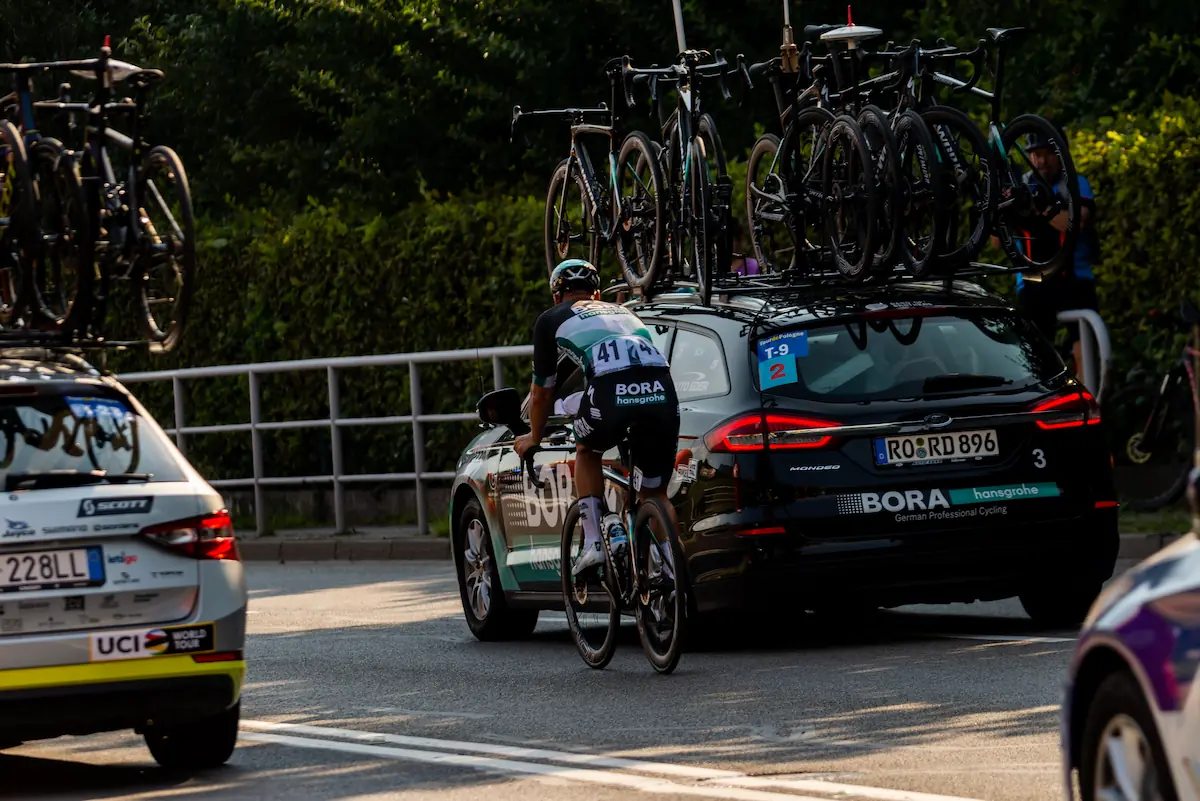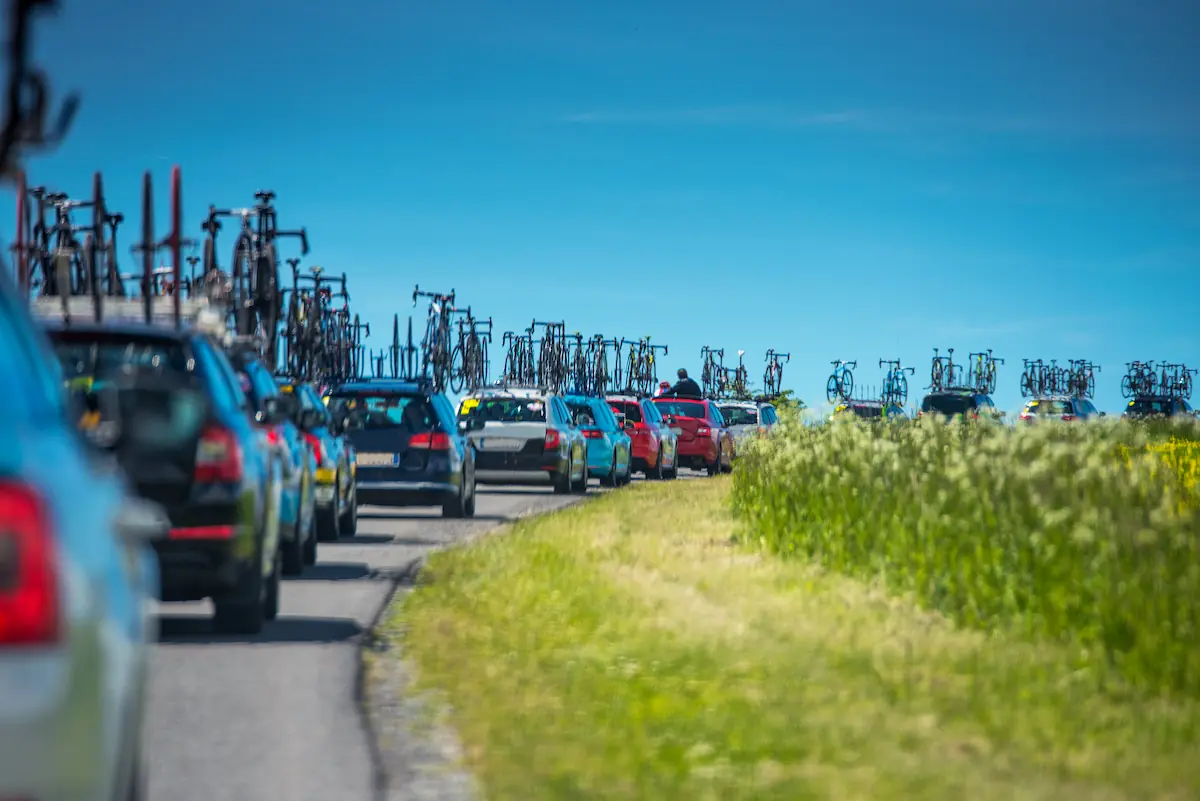Is he riding behind the car? Why is nobody reacting? Really, behind the official’s car!? Come on, that’s just stupid! Is this allowed? Surely not? Let me just check.
That’s probably the thought process that got you here. It’s actually the thought process of many new cycling fans when they first see a professional cyclist drafting behind the cars in the middle of the race, and nobody intervenes. Welcome to the world of cycling!
Although drafting a car is not allowed in the rulebook, the jury looks the other way in cases where a cyclist crashes, suffers a mechanical or takes ‘a nature break’ and has to rejoin the group. However, if the drafting is too long or too obvious, the officials may give the rider a time penalty.
Drafting behind cars is a bit of a gray area of cycling. It’s not allowed but regularly tolerated, which makes it hard to understand for any cycling fan and even more so for a new fan. That’s why I’ll try to explain it in this blog as well as possible.
When can cyclists draft behind the car?
Technically, cyclists can never ride behind a car. But that does not stop them from doing it, as they are often not penalized for it.
In reality, the Commissioners, who are the judges in cycling, allow riding behind the car as long as it does not give the cyclist an unjustified advantage over other riders.

In other words, cyclists can draft cars after a crash or mechanical problems, i.e., when they are not dropped from the main group due to lack of fitness. They can also draft cars when they take ‘a nature break’ or drop back to get the water bottles from the car and need to return to the group.
However, they can’t draft the car in the last kilometers of the race, especially in the last 3 kilometers. Also, the Commissioners allow drafting only for riders behind the main group. If a cyclist is in a breakaway, he cannot draft a car.
Drafting a car is not allowed but is regularly tolerated.
On the other hand, if the cyclist is dropped from the main group due to poor form and struggles to come back, he cannot ride behind the car. In this case, the Commissioners will give him a time penalty, or he can be disqualified from the stage if he happens to get a decent result after drafting a car.
So, in short, if you’re dropped due to force majeure, you can help yourself back into the group by riding behind the cars, but if you’re dropped due to lack of fitness, you’re not allowed to do that.
How long can a cyclist draft behind the car?
The time you can spend riding behind the car is not defined, as it’s illegal. But we have already established that in most cases it’s tolerated, but cyclists should not abuse the time spent behind a car.
Commissioners allow cyclists to spend as much time behind the car as is reasonable to get closer to the group. A cyclist must, therefore, not simply ride behind one car slowly and take a rest but must use the cars as a ladder to keep moving closer to the group he is returning to.

In most cases, a rider will spend a few seconds behind one car and then move to another all the way to the last car, which drives just behind the main group. From there, he can easily join the group.
If a cyclist were to ride behind only one car, he would be stuck far from the group, as cars drive in a single line and maintain order. A car can only move forward when Commissioners allow it, and they will never allow a car to move to bring the cyclist back to the group.
Can a cyclist draft behind any car?
In the biggest races, such as the Tour de France, more than 50 cars follow the peloton. Each team has two cars, and then there’s a bunch of organizers’ cars carrying the Commissaries, race director, doctors and other staff.
That’s a lot of cars to draft, but for a cyclist, his team car is most valuable. It will certainly help him the most, as it is the only one with the same goal as he has.
The Commissioners know this and are especially strict when cyclists ride behind their team car. They allow him to ride behind other cars much longer than behind his own. That was evident when Demi Vollering rode too long behind the team car, resulting in a 20-second penalty.
Cyclists are usually not picky about which car they draft as long as they benefit from it. They will even choose a race director’s or Commissioners’ car to move closer to the group. Commissioners don’t care which car cyclists use, as long as they don’t stay behind it too long.
What are the fines for drafting too long?
If a cyclist takes advantage of drafting and stays behind a car for too long, the Commissioner will impose a penalty. These are specified in the rules, but their wording gives the Commissioners considerable autonomy to adjust the penalty according to the seriousness of the violation.
Any infringement will result in a financial penalty for the cyclist, as well as for the driver and the Sports Director in charge of the vehicle. The fine is CHF200 (€214/$235) for the rider and CHF500 (€537/$588) for each team member in the car. Therefore, a single offence costs the team CHF1200 (€1290/$1414). Usually, teams pay the fines from the prize money accumulated in the race, which can be quite high in races like the Tour de France.
The Commissioners may impose a heavier penalty if the offence is more serious. In one-day races, this means disqualification, while in stage races, they usually issue a time penalty.
The rules state that the time penalty on a stage race can be between 20 seconds and 5 minutes. In the case of a serious infringement, a rider can also be disqualified in a stage race, although such cases are rare.
The most common penalties are financial fines and 20-second time penalties.
Why are the rules so loose?
In light of the text above, it is clear that when it comes to drafting, the rules are quite loose, or rather, their enforcement is loose.
Cycling is a sport taking place on terrain that is always different and leads to various situations. It is, therefore, much harder to define the rules strictly as you can in football or basketball because there can always be a situation that is not fully defined in the rulebook.
That is why Commissioners are equipped rather with guidelines within which to operate. This way, they can be flexible and tailor penalties to the individual case rather than applying a one-fit-all penalty.
Less strict rules with heavy oversight are harder to abuse.
Historically, it has been proven that having a free hand and being deliberate in punishment is better than blindly following strict rules. This also makes cyclists less likely to look for loopholes, knowing that the penalty will ultimately be decided by the official and not by the rulebook.
Conclusion
In conclusion, cycling’s stance on drafting behind cars is a complex mix of rules and tolerance. While not officially allowed, it is often permitted in specific situations, primarily when cyclists face unexpected challenges like crashes or mechanical issues.
There’s no fixed time limit for drafting, but as long as it’s reasonable, the Commissioners usually look the other way. Cyclists usually prefer the team cars, but the Commissioners are stricter when they see a cyclist drafting behind his own team car.
Penalties for excessive drafting involve financial fines and time penalties, with disqualification possible in severe cases. However, the rules are adaptable, allowing officials to make decisions based on specific circumstances.

